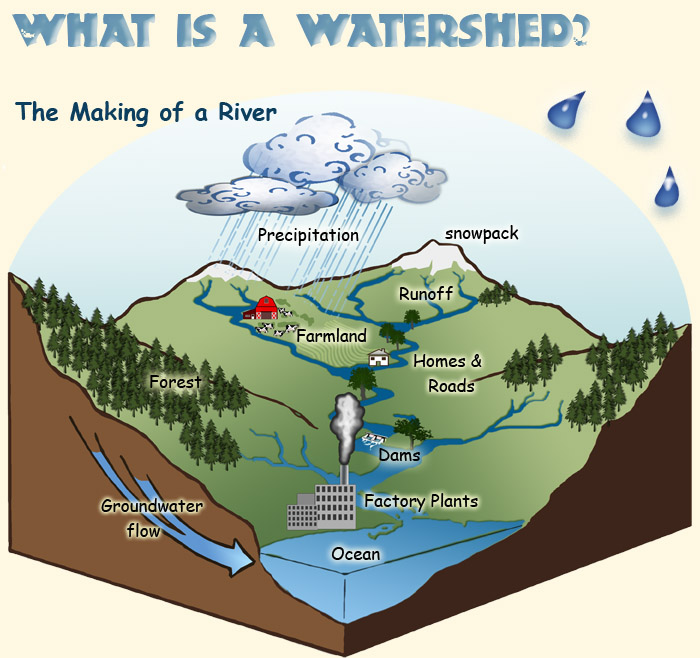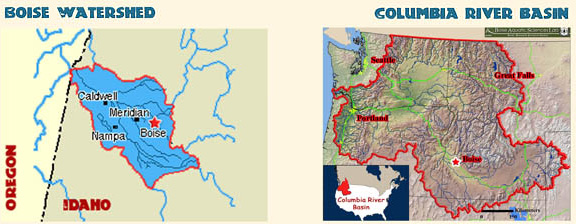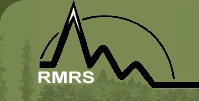|
|
AWAE Program Headquarters
322 East Front St., Ste 401
Boise, ID 83702
(208) 373-4340
Rocky Mountain Research Station Headquarters
2150 Centre Ave., Bldg A
Fort Collins, CO 80526
(970) 295-5923
|
|

|
|
| Forest Service Research and Development has created a new web presence. You will be redirected to the new page in a moment. Please update your bookmarks. |


When using this image: Image Credit. A. Vicente, U.S. Forest Service.
|
| A Watershed is an area of land where all of the water that is under it, or drains off of it collects into the same place (e.g. The River). Most of the watersheds in Idaho are part of the Columbia River Basin Watershed, which drains into the Pacific Ocean! |
 |
Precipitation
Imagine all of the rain that falls up on those steep mountains in the distance... When water hits a steep surface, there is only one way for it to go: downhill! gravity pulls water downhill as fast as it can taking the easiest path it can find. This water (including melted snow) eventually comes together (runoff) to form small streams which meet other streams further down and so forth until a river is formed. Where is it going you may ask? Well some of it seeps into the ground to form groundwater, some is used by people and animals then recycled, but most of it flows until it reaches sea level, which is usually the ocean, but also may be a large lake. |
 |
The Health of a River
Throughout a river's journey to the ocean, it flows through a landscape that is rich in diverse land uses from lush forests and deserts to farmland, cities and manufacturing plants. Each of these environments has an impact on the river's health. In natural environments like forests, trees and other plants build up on the river banks, dropping leaves, logs and other organic debris into the water. This provides nutrients to feed other organisms as well as hiding places for creatures to live in.
Human developed environments on the other hand often negatively affect the cleanliness and health of a river. Farmlands for instance create an unnatural feeding ground where animals such as cows graze on the plant life that keeps the river bank stable and healthy, while also overloading it with animal waste.
Paved surfaces like streets, parking lots and driveways for instance create a surface for water to run off too quickly increasing flood risks and also washing down harmful chemicals and other human waste.
There are many other human alterations to the environment that can severely damage our river ecosystems. |
 |
Dams
Dams are a great source of electricity for Humans-- it's better for the environment because it doesn't release harsh chemicals and smoke into the atmosphere. Dams work by holding water behind them, and then slowly letting the water out through turbines. As the water pushes these turbines, electricity is produced! For fish however, dams make for an incredibly rough journey to and from the Pacific Ocean.... There are 9 dams between Boise, Idaho and the Pacific Ocean! The good news is that people are constantly working on methods to transport Salmon and other anadromous (fancy word for a fish that spend part of its life in fresh water and the other part in salt water) fish safely across dams. |
 |
Ever wonder what your local watershed looks like? This first picture shows the Boise River Watershed which is formed by rain, snow, runoff and ground water seeping from the nearby mountains and hills! Our local watersheds are a part of a much bigger picture: if you were to zoom out (picture #2) you would see the entire Columbia River watershed! The ocean passage of this river cuts through the border of Washington and Oregon.

|
| |
|
|
| |
|
|
|
|





